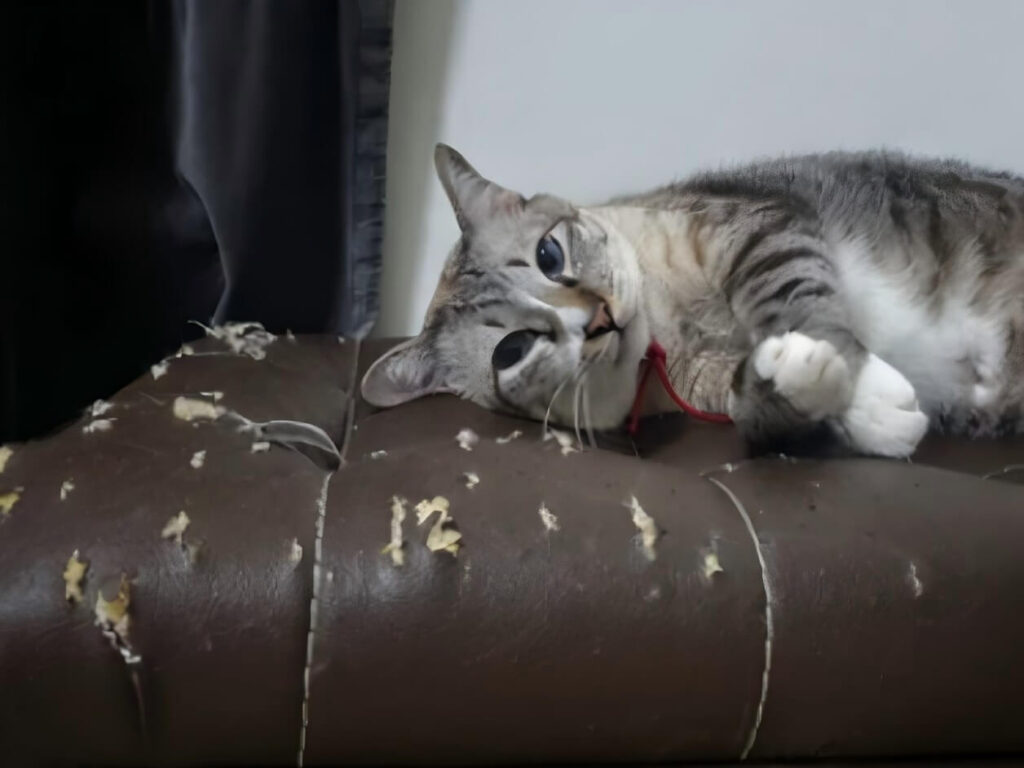Introduction
Cats scratching leather sofas can be a frustrating and costly problem for pet owners. As much as we adore our feline companions, their natural urge to scratch often results in unsightly damage to our beloved furniture. But before we become too exasperated, it’s important to understand why cats behave this way. By recognizing the root causes of scratching and implementing the right solutions, we can help protect our leather sofas while keeping our cats happy. This article explores various strategies to prevent cats from scratching leather furniture, including understanding the problem, providing alternatives, and implementing effective training methods.

Understanding the Problem
The Natural Instinct of Cats to Scratch
Scratching is an instinctive behavior for cats, and it’s not something they do out of spite. Cats scratch to mark their territory, keep their claws healthy, and stretch their muscles. This behavior is ingrained in their DNA, and it serves several important functions, such as removing the outer layer of their claws and releasing pent-up energy.
The Attraction of Leather Sofas for Cats
Leather sofas are particularly vulnerable to scratching because of their texture. The smooth, cool surface of leather is irresistible to cats, who find it appealing both as a material to scratch and as a cozy spot to rest. The scent of natural leather may also attract cats, encouraging them to investigate and leave their mark.
Common Reasons Behind Scratching Behavior
Cats may scratch leather sofas for various reasons. They could be bored, anxious, or simply trying to sharpen their claws. Stress, lack of environmental stimulation, or a sudden change in the household can also lead to increased scratching. Identifying the underlying reasons behind this behavior can help in finding an effective solution.
Providing Appropriate Alternatives
Providing Scratching Posts or Boards
One of the most effective ways to stop your cat from scratching your leather sofa is to provide appropriate alternatives. Scratching posts or boards give your cat a designated spot to satisfy their scratching needs.
Choosing the Right Type and Material
When choosing a scratching post, opt for materials that cats find appealing, such as sisal, carpet, or cardboard. The post should be tall enough for your cat to fully stretch while scratching, and it should be sturdy to prevent it from tipping over during use.
Placement and Proper Encouragement
Place the scratching post near the leather sofa or in areas where your cat frequently scratches. You can also sprinkle catnip on the post to attract your cat to it. Encouraging your cat to use the post instead of the sofa requires patience, but with the right placement and rewards, it can be highly effective.
Using Deterrents on the Sofa
In addition to providing alternatives, you can use deterrents to discourage your cat from scratching the sofa.
Scent-Based Deterrents
Cats are sensitive to certain smells, and you can use scent-based deterrents to keep them away from your leather furniture. Citrus, lavender, and eucalyptus are scents that cats tend to dislike. Spraying a safe, cat-friendly citrus spray on your sofa can make it less appealing to your cat.
Physical Barriers
Physical barriers like double-sided tape or furniture covers can also discourage scratching. Cats dislike the sticky texture of tape, and covering your sofa with a protective throw can shield it from damage while your cat adjusts to using the scratching post.
Training and Conditioning Techniques
Positive Reinforcement
Positive reinforcement is a powerful tool when it comes to modifying a cat’s behavior.
Reward-Based Training
Whenever your cat uses the scratching post instead of the sofa, reward them with a treat, praise, or affection. Consistent rewards will reinforce the desired behavior over time.
Catnip and Other Incentives
Catnip can be a useful incentive for training. Sprinkling it on the scratching post can encourage your cat to interact with it. Some cats are also motivated by toys or special treats, which can be used as part of the training process.
Redirecting and Discouraging Unwanted Behavior
Sometimes, despite your best efforts, your cat may continue to scratch the sofa. In such cases, it’s important to redirect their behavior.
Distraction Techniques
When you catch your cat in the act of scratching the sofa, try redirecting their attention with a toy or a distraction, such as a laser pointer or a feather wand. Engaging them in play can help burn off excess energy and reduce the urge to scratch furniture.
Voice Commands and Prevention Methods
Using a firm but calm voice to say “no” when your cat scratches the sofa can help discourage the behavior. Over time, your cat may associate the command with stopping the action. It’s important to avoid punishment, as this can create fear and anxiety, making the problem worse.
Ensuring a Cat-Friendly Environment
Providing Environmental Enrichment
A stimulating environment can reduce your cat’s urge to scratch in unwanted places.
Toys and Interactive Playtime
Toys that mimic prey, such as feather wands or laser pointers, provide mental stimulation and physical exercise. Regular interactive playtime can keep your cat entertained and less likely to scratch furniture out of boredom.
Vertical Spaces and Hiding Spots
Cats love to climb and hide. Providing vertical spaces, like cat trees or shelves, along with cozy hiding spots, can help satisfy your cat’s natural instincts. This can reduce anxiety and give them a designated space to relax and scratch.
Identifying and Addressing Potential Stress Factors
Stress can lead to destructive scratching. Identifying and addressing the sources of stress in your cat’s environment is crucial.
Separation Anxiety
Cats can develop separation anxiety, especially if they are left alone for long periods. Ensuring your cat has plenty of stimulation, company, or toys can help alleviate this stress.
Lack of Scratching Options
If your cat lacks sufficient scratching options, they may turn to your leather sofa. Make sure there are multiple scratching posts or boards available throughout your home to give your cat plenty of choices.
Upholstery Protection Measures
Using Protective Covers or Throws
To protect your leather sofa from scratches, you can use protective covers or throws.
Leather-Friendly Covers
Invest in leather-friendly covers that are specifically designed to shield your sofa from damage. These covers are usually made from materials that are easy to clean and maintain while offering a layer of protection against claws.
Regular Cleaning and Maintenance
Regular cleaning and maintenance of your leather sofa can prevent small scratches from becoming bigger problems. Use leather conditioners to keep the material supple and reduce the visibility of minor scratches.
Trimmed Nails and Soft Paws
Keeping your cat’s nails trimmed is another effective way to minimize damage to your leather furniture.
Nail Clipping Tips
Regular nail trimming helps reduce the sharpness of your cat’s claws. Use a proper cat nail clipper, and trim only the sharp tips to avoid cutting too much and causing pain.
Temporary Nail Covers
Temporary nail covers, such as soft paws, are another option. These soft, flexible covers fit over your cat’s claws and can prevent them from causing scratches while still allowing the cat to scratch naturally.
Frequently Asked Questions
1.Can Declawing Solve the Problem?
Declawing is not recommended as a solution to scratching. It is a painful procedure that can lead to behavioral and health issues. Instead, focus on training and providing alternatives to manage scratching behavior.
2.Are There Any Specific Deterrent Sprays Available?
Yes, there are cat-friendly deterrent sprays available that use scents like citrus or lavender, which cats generally dislike. These sprays can be applied to furniture to deter cats from scratching.
3.What If My Cat Continues to Scratch Despite Efforts?
If your cat continues to scratch despite your efforts, consult with a veterinarian or animal behaviorist. They can provide additional insights and recommend solutions tailored to your cat’s specific needs.
4.Can I Train an Older Cat to Stop Scratching?
Yes, older cats can be trained to stop scratching furniture. While it may take longer to change established habits, consistent training, and positive reinforcement can yield positive results over time.
Conclusion
Stopping your cat from scratching your leather sofa requires patience, understanding, and the right tools. By providing appropriate alternatives, using deterrents, and reinforcing positive behavior, you can protect your furniture while keeping your cat happy and healthy. With these strategies in place, you can enjoy a scratch-free sofa and a well-adjusted feline companion.
